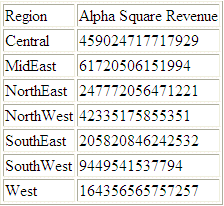Reference: Usage Notes for the DB_EXPR Function
- The expression must return a single value.
- Any request that includes one or more DB_EXPR functions must be for a synonym that has a relational SUFFIX.
- Field references in the native SQL expression must be within the current synonym context.
- The native SQL expression must be coded inline. SQL read from a file is not supported.
Example: Inserting the DB2 BIGINT and CHAR Functions Into a TABLE Request
The following TABLE request against the WF_RETAIL data source uses the DB_EXPR function in the COMPUTE command to call two DB2 functions. It calls the BIGINT function to convert the squared revenue to a BIGINT data type, and then uses the CHAR function to convert that value to alphanumeric.
TABLE FILE WF_RETAIL
SUM REVENUE NOPRINT
AND COMPUTE BIGREV/A31 = DB_EXPR(CHAR(BIGINT("REVENUE" * "REVENUE") ) ) ; AS 'Alpha Square Revenue'
BY REGION
ON TABLE SET PAGE NOPAGE
ENDWF_RETAIL is a sample data source you can create by right-clicking an application on the Reporting Server Web Console and pointing to New and then clicking Tutorials from the context menu.
The trace shows that the expression from the DB_EXPR function was inserted into the DB2 SELECT statement:
SELECT T11."REGION", SUM(T1."Revenue"), ((CHAR(BIGINT( SUM(T1."Revenue") * SUM(T1."Revenue")) ) )) FROM wrd_fact_sales T1, wrd_dim_customer T5, wrd_dim_geography T11 WHERE (T5."ID_CUSTOMER" = T1."ID_CUSTOMER") AND (T11."ID_GEOGRAPHY" = T5."ID_GEOGRAPHY") GROUP BY T11."REGION " ORDER BY T11."REGION " FOR FETCH ONLY; END
The output is:
